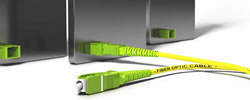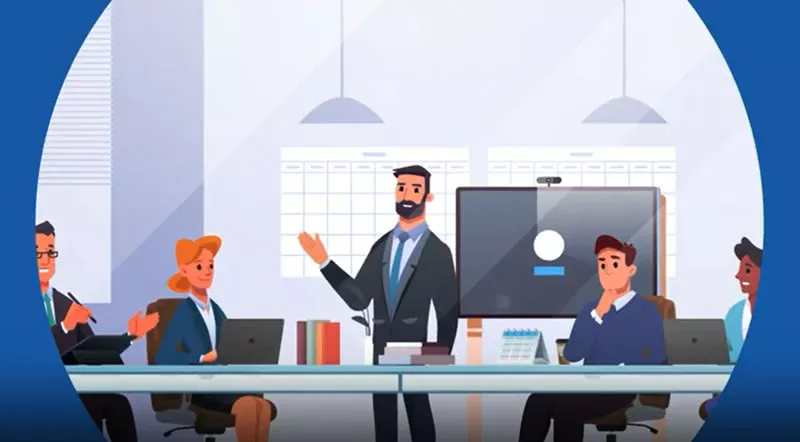Broadband Linkup
More ISPs Are Offering ‘White Glove’ Wi-Fi Service for Better Consumer Experience
“There's so many things that can affect Wi-Fi signals and I don't think people are aware of them. They are basically a radio wave and the faster the radio wave, the more sensitive it is.”

Chris Boring
VP, Sales and Marketing, Promptlink Communications
Here’s a hypothetical for you: At home, would you rather have electricity or Wi-Fi internet? It’s not necessarily a “chicken or the egg” scenario with today’s advanced wireless solutions. On this episode of Broadband Linkup by Promptlink Communications, host Sean Heath sat down with Chris Boring, Promptlink’s vice president of sales and marketing, to discuss all things Wi-Fi.
The scope of services is evolving for internet service providers, who have gone from basic “utility” companies to offering full-service, white-glove assistance for its customers upon request.
“If they’re providing internet and the internet is slow, they’ll get blamed even if the real problem is the wi-fi router that the customer bought from Best Buy,” Boring said. “So they figure, why not go all in, provide wi-fi services, and connect all those devices in the home?”
ISP offerings range from leased Wi-Fi routers, to in-home Wi-Fi surveys, to complete suites of Wi-Fi devices that link together to create a managed service. This helps alleviate the pain points for both consumers and ISPs, Boring said.
Another pain point for service providers is managing device qualification in the home and ensuring device connectivity each and every time. While providers have devices tested and certified to work in laboratories, routers with possibly different versions of firmware can cause unexpected incompatibility when produced en masse and then deployed to homes.
“When customers try to connect to Wi-Fi from so many different devices and each of those devices has its own characteristics, that’s a challenge,” Boring said. In fact, the average home has over nine connected devices via Wi-Fi.
With these challenges, white glove services are helpful for less-technologically adept customers and represent some of the many ways Wi-Fi is integrating into our lives more every day.
00:00:02
Daniel Litwin: You’re listening to Broadband Linkup, your source for broadband industry info with Promptlink Communications.
00:00:15
Sean Heath: Welcome to broadband Linkup by Promptlink Communications. I’m your host Sean Heath. Wi-Fi is quickly becoming a constant presence in every one of our lives. I would almost say it’s almost as important as electricity, but then how would you, if you didn’t have electricity, how would you have Wi-Fi? See, it’s not a perfect analogy. You know, somebody who has a lot of patience with my imperfect analogies is my guest on the podcast today. He’s the Vice-President of Sales and Marketing for Promptlink Communications, Chris Boring. Chris, how are you, my friend?
00:00:47
Chris Boring: Hey, Sean. I’m good. How are you?
00:00:49
Sean Heath: I’m doing quite well. That is really a bad analogy, right, saying that Wi-Fi is almost as important as electricity?
00:00:56
Chris Boring: Well, not if you’re in my house because I’ve got a UPS hooked up to my cable modem and my router. So when the power goes out, we still have Wi-Fi and we still have internet for all those devices like tablets and everything that don’t need power and laptops. It’s all there, man. It’s just as important or maybe even more. I don’t know. If you ask my teenage daughter, she’ll say, “It’s more important.” She’ll surf in the dark.
00:01:22
Sean Heath: That’s hysterical. And I feel smarter already. We’ve only been talking for 45 seconds. This is going to be a good day for me, Chris. I always like talking to you.
00:01:30
Chris Boring: Same here, Sean.
00:01:32
Sean Heath: All right. So let’s talk about the growth of Wi-Fi because it’s a new approach but almost the same sort of service mindset, I guess, that service providers are now starting to come into that concierge last few feet, the white-glove service portion of bandwidth provision. They’re not just stopping at the walls and they’re not stopping at a cable box. They’re actually helping the additional 20, 30 feet from our devices and helping us bridge that last few steps. That’s a pretty bold move for a service provider. That’s an exponential increase in responsibility, I would think.
00:02:14
Chris Boring: It is and it’s also a revenue source for the and a necessity because I think for them they looked at it and said, “Well, we’re providing internet and if the internet is slow, we’re going to get blamed anyway,” even if the real problem is the Wi-Fi router that they bought, the customer bought from Best Buy. So why not go all in, make a little money, provide Wi-Fi services and connect all those devices in the home in one place and have some control over it?
00:02:41
Sean Heath: Now that adds in and an additional layer of responsibility because it makes sense for cable operators to manage device qualification inside the homes.
00:02:55
Chris Boring: It does. And it’s all telecom providers. I mean, we talk about cable operators, but it’s the same whether it’s a cable operator or a Verizon Fios or any other of the telecom providers that are out there. They’re offering internet service and then they’re layering on top of Wi-Fi service. And to your point about taking responsibility, it even varies in the way that operators choose to offer that service. Some will just add on a Wi-Fi router and lease that to the customer every month and the customer manages it. Others like Comcast for example have a complete suite of Wi-Fi devices that link together to provide a managed service that they can have more control over so that if they have to take responsibility, at least they have some level of control.
00:03:50
Sean Heath: And you do mention and you’re absolutely correct in saying the service providers are going to get blamed whether the slow Wi-Fi connection from somebody’s tablet to the internet is their fault or not. So you might as well be able to step in and help reduce that pain point. There are a lot of pain points for both sides of this transaction, for the cable operators and for the end Wi-Fi users. What are a few of the pain points that cable operators are having to deal with?
00:04:15
Chris Boring: Well, there are a few things. First of all, they’ve got different models of the way they deploy it. The service can be deployed in a combined all-in-one unit, which doesn’t always have the best performance overall. You know, as you say jack of all trades, master of none, it’s trying to do a lot of things. The best way technically for them to deploy it would be a separate Wi-Fi device which many of them do and then a cable modem or fiber modem for internet and then even a separate modem to provide phone service when that’s being used. But their real pain point is for them, first of all, they’ve got devices that in their laboratories before they ever bought one or deployed one, they tested some prototype or some original version of a device and made sure the Wi-Fi was good and the internet was good and everything else and then they bought a hundred thousand of them in mass production with whatever firmware version they come on and deploy them to the homes. And then the real pain point comes, first of all, when they’re in the homes, customers try to connect to them from so many different devices. I mean, the average home has over nine connected devices via Wi-Fi for each home. It’s hard to fathom.
So each one of those devices has its own characteristics. It’s trying to connect to one Wi-Fi router, and that’s a challenge. So half the time it’s how do you optimize it for customer devices. And then again, the other part is you’ve got a device that while you certified it before you purchased it, you have to find a way to make sure that those devices, when they are mass produced and shipped to you, maintain that same level of quality that you certified in the beginning.
00:06:19
Sean Heath: I have heard the phrase, “It is what it is,” mentioned in so many different contexts. That doesn’t really fly when you’re talking about Wi-Fi. Consumers don’t accept it is what it is. They don’t accept, “Here are the limitations of this thing.” Are we a little unrealistic as consumers do? Are we getting spoiled with just how great Wi-Fi is?
00:06:40
Chris Boring: I mean, certainly there may be unrealistic expectations if you’re if people are not technically savvy. You know, as I said before, they have some device, I mean you have a five-year-old iPad that you’re trying to connect to a modern Wi-Fi router where the standard is changed three times since that iPad was purchased and you expect that iPad to be as fast as the new I9 laptop with wireless AX protocol on it, it’s just not going to happen. So there’s definitely that unrealistic expectation where people compare speeds from different devices in their home and they say, “Oh, something’s wrong. My laptop is fast and my five-year-old iPad is slow. It’s your fault. Why are you providing me with crappy Wi-Fi service,” right?
00:07:36
Sean Heath: That’s almost like complaining, like blaming the kitchen at a restaurant for the fact that their fork is bent. The chef had nothing to do with your fork being bent.
00:07:47
Chris Boring: Yeah.
00:07:48
Sean Heath: That’s a different department. Wi-Fi is becoming so critical in our home lives. I wonder two questions. Number one, will that last or is there going to be something that comes down the line and is there a theoretical additional communication protocol that could supplant Wi-Fi? And my second question would be, do you think that service providers also have to be concerned about home builders including Wi-Fi as a new part of new home buildings?
00:08:23
Chris Boring: As far as technology goes, you know, we know that goes inside. The only constant is change. So definitely technology will change, operators will try to keep up with it as best they can. I think the main threat today if we look at what’s out there to a Wi-Fi connection or even a home internet connection is the 5G service that is starting to be offered by the various T-Mobile and Verizon, the mobile 5G service to the point where people, may at some point, when that gets fast enough, rely on that type of a device the same way that they are cutting out their old school cable boxes for TV and using over-the-top video services like Hulu or Netflix. So that, I can certainly see that happening. But whether it’s the cable operators with new DOCSIS technology that just gets faster and faster and faster, the current DOCSIS 3.1 is magnitudes faster than the previous version, they can offer over one gig services now to homes. I have over 500 meg internet service at home, and it’s nothing special, you know, to them right now.
So to continue to push that, they’ll push, right? They’ll continue to change technology, the mobile guys will continue to change their technology, and as consumers, we just benefit from this competitive atmosphere.
00:10:03
Sean Heath: Well, as far as 5G is concerned, I have two events that have tempered my excitement somewhat. Number one, I was excited when Google Fiber was a thing and that still hasn’t materialized and I’m still waiting on my rocket car, my flying car that I was promised in like 1982. It’s still not here. So any day now, I’m sure it’s going to show up, Amazon’s going to bring it to my door. So I’ll get excited about 5G when I actually see it in action. Now one of the things that we have not talked about today, we talked about the consumer, the home residential side of Wi-Fi. You deal on the commercial level as well. I’d like to talk about the Wi-Fi experience in the supply chain, if we could for a minute.
00:10:51
Chris Boring: Sure. So Wi-Fi devices are everywhere, whether it’s the new RoboVac I have at home that’s Wi-Fi controlled or it’s my thermostat that’s Wi-Fi controlled or my refrigerator, I don’t have that, that’s Wi-Fi controlled, it’s everywhere, and supply chain is no different. And interestingly enough when we look at what we’re doing in our core business, testing some of these devices, they usually get deployed into the supply chain. So we have a test platform that will sit in a big Warehouse that’s handling all the supply chain activity, and guess what, the Wi-Fi scanners, the Wi-Fi automation, the Wi-Fi security, all the Wi-Fi signals in the air make it impossible to test a Wi-Fi device without somehow shielding that device from other signals.
So it’s everywhere in the supply chain. So it’s just as critical in the supply chain and also for these operators in a commercial environment like hospitality, in hotels, hot spots which are everywhere, all of these things. So there are so many connected devices. And as you said, almost all of them go through Wi-Fi. So it’s absolutely critical that that Wi-Fi box works the way it should, whether it’s a home or a commercial device.
00:12:18
Sean Heath: What do you think would surprise people the most about Wi-Fi that most people probably don’t even think about?
00:12:24
Chris Boring: You know, I think for someone who’s not that technical, I think the fact that so much of it is just radio waves. It’s just radio waves. So when you’re talking about why you have slow service somewhere or slow Wi-Fi somewhere, it’s not just the distance. It’s what’s between you and the router. Is there a wall? Are you in an old home with plaster walls? There are so many things that can affect those Wi-Fi signals that I don’t think people really think of it as a radio wave, which is basically what it is. And also that the faster the radio wave, in some ways the more sensitive it is to some of these things.
Also, I think I don’t think people realize, when you’re looking at say the older Wi-Fi devices, when you say the 2.4 gigahertz devices or you hear Wireless-B or Wireless-N, that was really the first generation of Wi-Fi and there’s very few channels, very small spectrum, frequency spectrum, so there aren’t so many channels. So with all these Wi-Fi devices that you have in your home or you have in your business, there’s only so many channels that they can use to connect and they get crowded very quickly. The reason that everybody sees so much better performance on the newer 5-gigahertz routers is because there are so many more channels and it’s a much bigger frequency range. So it’s easier to find a channel that’s not so crowded.
00:14:10
Sean Heath: So it’s basically the difference between having a hot plate and having a Viking gas stove with six burners?
00:14:17
Chris Boring: Yeah, that’s a good analogy.
00:14:19
Sean Heath: I got one.
00:14:20
Chris Boring: See, you can get good analogies.
00:14:22
Sean Heath: Yes, finally. Well, here’s the thing, Chris. If you throw enough junk up against a wall, eventually something’s going to stick. We talked about managing the devices, but we haven’t talked about the speed that’s in our homes now. You mentioned that there are more connections, but those connections are then becoming inherently faster. I’m assuming that’s because all these internet devices that cable operators and telco operators are putting into our homes, obviously they’re being tested rigorously and we’re not getting lemons. We’re getting the best, fastest, most tested devices. That’s what’s coming. I mean, obviously that’s what you would offer, right?
00:15:01
Chris Boring: Yeah. Yeah. I mean, there’s two things that are really giving you the faster speeds. One is, as I was just saying, is the actual technology itself, right? So the technology has improved. So there’s the ability to go faster, right? So there’s that theoretical speed and then there’s the practical speed. So the practical speed depends on so many factors, both the client device, as we said before whatever the customer has, the device you’re connecting to, the environment around you, some of the services that are offered now by operators include doing a Wi-Fi survey of your home. And what does that mean? They go in and they find the optimal location to place the router where the signal will be equally fast in any part of your home and they have also devices that are extenders that you’ve seen. You’ve seen things like your mesh, wireless mesh. These are multiple little Wi-Fi pods that can go around your house and extend the Wi-Fi into the areas that may not have good coverage anyway or without them.
So this extends the speeds quite a bit. It also extends the capacity to connect multiple devices, but none of that matters if as you say the device that you put in the home isn’t working properly and testing that Wi-Fi signal in these devices that in most cases have been recycled from one customer to another is a big challenge.
00:16:42
Sean Heath: How do you really go about testing that? If you bought a hundred thousand of something, you can’t test each one of those individually, right?
00:16:48
Chris Boring: Well, generally what the operators will do is if it’s a brand new device coming in out of the box, they figure you don’t need to test it. It should be good. You should have a .01% rate and they’ve done their qualifications before purchasing the device. So the first generation box they get brand new, they just send out to the customer. That part’s easy. But at the point where you have to understand these boxes are going to be continually recycled throughout their life. So when you move from one house to another and maybe you change who your provider is, that box, that cable modem, or that that Wi-Fi box comes back to the operator and they get thousands of these every day, thousands and thousands of these every day, and they have to have some way to figure out which ones are actually functional and which ones have a problem and that presents a big challenge for them.
So in the past, you know what? It was an internet box, it came back, we have testers, there are other testers out there, and these appliances go into the customer’s warehouse. They sit in the warehouse. They get a box. They plug it in, it runs through a test, and it gives them the green light for good box and a red light for a bad box, and that’s it. And that was challenging both for us and them but not terribly.
Now with all of the focus on Wi-Fi as we’ve been talking about, they get these boxes back, and what’s the most important thing on that box? If it can do internet, the most important thing is the Wi-Fi working and is it fast, and that’s where the challenge really comes in for the operators because as we said they’re trying to test in their supply chain environment with all of the Wi-Fi devices that are there not to mention just the Wi-Fi devices themselves that they’re trying to test. And if they have no way to shield those boxes from these signals, you can’t get a good Wi-Fi test out of them because interference stops them from performing well.
00:18:54
Sean Heath: I can’t imagine having to just build a Faraday cage and manually walking each of these boxes and they’re testing it and walking out, getting the next one. There’s no way that’s physically possible.
00:19:05
Chris Boring: You know, you’re right. And when you look at a traditional Faraday cage or even the Faraday cages they use for qualification of the device, it’s a large box, you can put one modem in it or one Wi-Fi router in it at a time and it takes 10 or 15 minutes to test and it costs them $300,000 to $400,000 as an operator for one of those Faraday cage test environments.
So we looked at this and said, “Well, there’s got to be some way to do this that is scalable to the thousands of devices that are coming in every day for these guys.” And the answer was that we ended up creating over the last four years a mini Faraday cage that could be put in to one of our test platforms that has say 20 positions in it and it’s got a garage door. They got the garage door on the front. They open the garage door. They connect all the cables. They put the device in, they close the door, and the device starts testing, and they can test 20 at a time. They all test in parallel. It’s pretty easy to do. It’s a fast system so the main challenge for the operator is making sure somebody takes out the one that passes or fails and puts in the next one, but it solves all the problems.
And it not only can test that the Wi-Fi is functional, our system is one of the only ones that I know of that can actually run bandwidth test and signal strength test in a 5 to 10-minute test and qualify all these devices. So that’s what they’re using today and that’s one reason as you said earlier you’re getting that fast service at home. And if you’re not getting it, it’s very likely that the operator is not doing this type of test before they give you that box.
00:21:05
Sean Heath: Today’s guest on the podcast has been the Vice-President of Sales and Marketing for Promptlink Communications, Mr. Chris Boring. Chris, I hope you have a wonderful weekend and I can’t wait to talk to you again my friend.
00:21:15
Chris Boring: All right, Sean. Sounds good. Appreciate it.

How Technology is Improving the Broadband User Experience
Chris Boring
VP, Sales and Marketing, Promptlink Communications

El mundo está más dependiente al wifi. ¿Lo podemos diagnosticar apropriadamente?
David Mosquera
Director, Latin American Sales, Promptlink Communications

More ISPs Are Offering ‘White Glove’ Wi-Fi Service for Better Consumer Experience
Chris Boring
VP, Sales and Marketing, Promptlink Communications

How to Detect Noise in Cable Communications
Foad Towfiq
CEO, Promptlink Communications

What to Watch for at SCTE Cable-Tec Expo
Chris Boring
VP, Sales and Marketing, Promptlink Communications

Cable-Tec Attendees Have Been ‘Out of Control Amazed’ with Network NoiseHawk
Foad Towfiq
CEO, Promptlink Communications

Multiple Content Streams, Single Content Pipe
Alexander "Shony" Podarevsky
Senior System Engineer, Promptlink Communications

Restauración de equipos es la estrategia rentable y ecológica para una industria de telecomunicaciones creciente
David Mosquera
Director, Latin American Sales, Promptlink Communications








